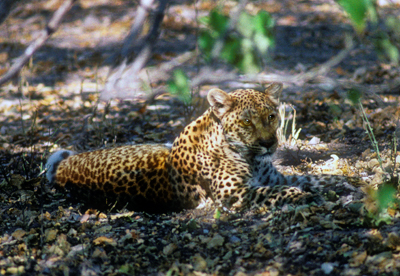Safaris, by definition, venture off the beaten track and into remote areas. Four-wheel-drive vehicles are usually necessary, and a driver or guide with good local knowledge may prove invaluable. It may be possible to hire a self-drive vehicle, and even avoid getting hopelessly lost, but can you spot the tail of a leopard amid tree branches at a distance of two hundred metres?
The cost of making your own arrangements can be quite high, but the advantages may make it worthwhile. If the vehicle is shared by a group of half a dozen people, the inevitable compromises must be made. Package tour safaris usually plan “game drives” early in the morning and late in the afternoon. However, they are designed to satisfy the demands of western tourists who want to see everything in a limited period. Consequently the photographic opportunities may be very limited – you may find yourself photographing a pride of lions with the light in the wrong direction and three other tourist vehicles as a backdrop. If you are serious about obtaining good images you need a great deal of time and patience, and you must be willing to react to the prevailing circumstances. When travelling independently, carry water, food, a map and a compass, and tell someone where you plan to go.
 This type of photography also demands suitable equipment, because it is not always possible or desirable to approach your subject closely. Animals and birds are easily frightened away, or perhaps just stressed sufficiently to change its normal pattern of behaviour. Telephoto lenses and stable camera supports are therefore essential. Bean bags are useful for steadying a camera and lens against part of a vehicle, but remember to turn off the engine to reduce vibration. The best option is a telephoto lens, preferably featuring vibration reduction or image stabilization technology, having a large maximum aperture such as f/2.8 and a focal length of at least 400mm. However, equipment of this quality is very expensive and bulky to handle. Teleconverters, which increase the focal length of a lens by a factor of 1.4x or 2x, are a useful compromise. Image quality will never match that of an expensive prime lens, but they are relatively cheap and easy to carry. Note that teleconverters decrease the maximum aperture of any lens by one or two stops respectively. Using a 2x converter, a 200mm f/4 lens therefore becomes a 400mm f/8.
This type of photography also demands suitable equipment, because it is not always possible or desirable to approach your subject closely. Animals and birds are easily frightened away, or perhaps just stressed sufficiently to change its normal pattern of behaviour. Telephoto lenses and stable camera supports are therefore essential. Bean bags are useful for steadying a camera and lens against part of a vehicle, but remember to turn off the engine to reduce vibration. The best option is a telephoto lens, preferably featuring vibration reduction or image stabilization technology, having a large maximum aperture such as f/2.8 and a focal length of at least 400mm. However, equipment of this quality is very expensive and bulky to handle. Teleconverters, which increase the focal length of a lens by a factor of 1.4x or 2x, are a useful compromise. Image quality will never match that of an expensive prime lens, but they are relatively cheap and easy to carry. Note that teleconverters decrease the maximum aperture of any lens by one or two stops respectively. Using a 2x converter, a 200mm f/4 lens therefore becomes a 400mm f/8.
Digital SLRs have an advantage in that their sensors are generally smaller than a standard 35mm film frame. This gives an image magnification factor of around 1.5 when using 35mm format lenses. A 200mm 35mm format lens will therefore be the equivalent of a 300mm lens when attached to a digital SLR. Maximum aperture is unaffected.
In dry conditions dust may be a real hazard for all photographic equipment, and in particular for digital cameras. Carry key items in zip-loc poly bags. In tropical conditions film must be kept cool and dry, and processed as soon as possible. Use cool boxes and silica gel where possible. Digital equipment consumes lots of power, so carry fully-charged spares and recharge all cells whenever possible.
In general, use the longest lens available, hold it absolutely steady and select a large aperture and a fast shutter speed. This reduces depth of field and so drops the background out of focus, and freezes any movement of camera or subject. Lenses featuring vibration reduction or image stabilization technology effectively give the photographer an additional two stops.






